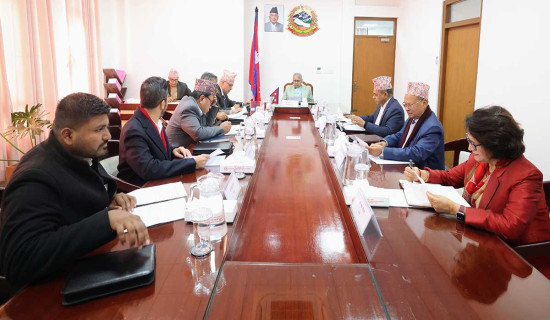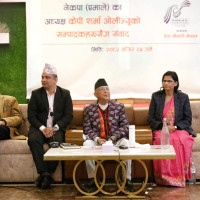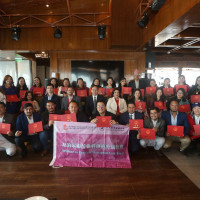- Thursday, 11 December 2025
Plastic pollution persists despite repeated prohibitions
Kathmandu, May 19: The plastic build-up in Kathmandu Valley's riverbeds illustrates the environmental consciousness, or lack thereof, among urban residents. It is common to see people disposing of their waste, often wrapped in plastic, along the banks of the Bagmati and Bishnumati rivers. Plastic pollution has emerged as a significant concern in the valley, with rivers heavily contaminated with plastic waste. Studies showed that around 27 per cent of plastic waste is openly disposed onto riverbeds.
A research paper published in Science Direct in 2024 titled “Microplastics research in Nepal: Present scenario and current gaps in knowledge by Kishor Kumar Maharjan, said, “With inadequate plastic management, around 20.7 kilo tons (9 per cent of total consumption) leak into the environment annually due to the absence of effective policies.”
The Government of Nepal initiated a significant step by banning plastics smaller than 20x35 inches and thinner than 40 microns on April 1, 2015. However, this effort lost momentum after the devastating April 25, 2015 earthquake, as recovery efforts took precedence.
In May 2022, the government introduced the Action Plan for Ban on Plastic Bags, which included four key strategies -- preventing the import of plastic bags thinner than 40 microns, banning single-use plastic bags thinner than 40 microns, providing grants to businesses for eco-friendly bags production, and encouraging individuals to use reusable bags while shopping.
Following this, several other districts, such as Parbat, Myagdi, Damak, and Ilam, have declared themselves plastic-free. But still, the single-use plastics or thinner than 40 microns have not gone away from shops across the country and the situation is worse in the city areas including Kathmandu.
The government has not yet effectively prevented city residents from encountering harmful substances, particularly single-use plastic, in their daily lives. There remains a significant gap in public awareness regarding the potential for everyday materials to leach into water sources, contributing to the formation of small particles or microplastics. Microplastics are small pieces of plastic, less than 5 microns in size, which cannot be seen by the naked eye and are very dangerous to living beings and the entire ecosystem.
In a newly released research study, scientists from the Centre for Analytical Sciences at KIAS and the Central Department of Chemistry at Tribhuvan University have reported that 45 per cent of the analyzed samples contained microplastics, with an average particle count of 73 per litre.
Notably, jar water samples exhibited a significantly higher particle count (99 per litre) compared to bottled water samples (59 per litre).
They have investigated the potential of using a smartphone microscope to detect microplastics in drinking water samples. This research published in the Microscopy Research and Technology Journal by Wiley-Liss Inc. reported microplastics in drinking water for the first time from Nepal.
Several studies have shown that humans globally ingest around 0.1-5g of microplastics weekly from various pathways, including food, water, and air. There are also reported cases of microplastics in the placenta of unborn babies, including blood, breastmilk, lungs, and stool, and they could reach every organ, including the brain.
Despite being a significant hazard to the ecosystem, the country has struggled to effectively control the presence of plastics smaller than 40 microns in the market.
Deepak Gyawali, spokesperson for the Department of Environment, stressed the need for individuals to reflect on why they continue to use such harmful plastics in their daily lives.
Why was the initiative not successful?
According to Gyawali, the government has prioritised the 3R approach -- reduce, reuse, and recycle, alongside efforts to raise awareness about minimising the use of single-use plastic, promoting collection for reuse, and segregating plastic waste for recycling. However, despite these efforts, transitioning away from plastic remains a significant challenge due to its entrenched use in our daily lives. Finding viable alternatives to plastic is vital for moving forward.
Gyawali said, “There is a lack of clarity in the law itself. Our role is limited to monitoring without the authority to take direct action. We submit reports, government bodies are responsible for enforcement. Also, many plastic production facilities operate without proper registration, often in small, unenclosed spaces. Identifying the sources of thin plastics is challenging. Therefore, our primary approach is to raise consumer awareness and encourage them to minimize plastic usage by providing alternative options.”
Many private and social organisations are actively engaged in plastic control efforts. While there have been some changes over the last five years, it will take time to implement control measures on a large scale. Plastic has become deeply ingrained in people's daily lives, making it a challenging habit to break, he added.
Environmentalist Bhusan Tuladhar said that single-use plastic is a behavioural issue. Controlling the market alone is insufficient, production must also be regulated. While alternatives to single-use plastics exist, their promotion is lacking. “We need intensive campaigns to control single-use plastics,” he said.
Asian countries like Thailand, Indonesia, Vietnam, and others are banning single-use plastics to combat pollution. In July 2020, Jakarta banned single-use plastics, and India followed in July 2022 with a ban on 19 items. Japan is also reducing single-use plastics, while Bangladesh was the first Asian country to implement a national ban. Despite these efforts, more intensive campaigns and self-awareness are needed to control single-use plastics, Tuladhar said.
Private initiative in curbing plastic pollution Aanand Mishra, founder and President of CREASION Nepal, stressed the significance of collaboration in tackling plastic pollution. He highlighted the necessity for cooperation among the press, global leaders, INGOs, NGOs, and all stakeholders to effectively address this issue. Mishra emphasized that by uniting efforts across sectors, we can achieve substantial progress in combating plastic pollution.
CREASION Nepal and its youth members have been recycling 500 metric tons of plastic every month collected from parts of Kathmandu, Chitwan and some other cities of the country.
The Collaborative Approach for Preventing Plastic Leakages in Rivers (CAP), initiated by Creation, focuses on curtailing plastic waste flow into rivers. “This is one of our many efforts in waste management, particularly plastic pollution. Through networking and adopting copyleft principles, we express our dedication to this cause," Mishra said.
Given that plastic pollution affects humanity and the planet as a whole, this year's World Earth Day theme, "Planet vs. Plastic," underscores the urgency of addressing this issue.
Similarly, the theme for UNESCO World Press Freedom Day, "A Press for the Planet: Journalism in the Face of the Environmental Crisis," highlighted the role of media in raising awareness about environmental challenges.
According to statistics of the Department of Customs, Nepal imported around 380,000 tonnes of plastic and plastic articles in fiscal years 2021/22, with domestic production estimated to be around 165,000 tonnes. The majority of plastics in Nepal end up in the environment due to a lack of plastic management mechanisms.
Due to inadequate plastic management and the absence of effective policies, approximately 20.7 kilotons (9% of total consumption) leak into the environment annually.
Sujata Koirala, a circular economy expert, said that this is directly related to Nepal's lack of policies for managing plastic waste. Furthermore, such issues are exacerbated by a lack of data on plastic waste, which is critical for driving policy decisions.
To effectively manage plastic waste, three major issues must be addressed: waste collection and processing; and Extended Producer Responsibility (EPR). The Organisation for Economic Cooperation and Development (OECD) defines EPR as ‘an environmental policy approach in which a producer's responsibility for a product is extended to the post-consumer stage of a product's life cycle.’ EPR ensures that plastic producers, manufacturers, and importers share responsibility for plastic waste management.
EPR is a tried-and-true method of incentivising sustainable product design in addition to recycling. For EPR policy to be effective in developing countries, it should focus on differentiating producer responsibility based on recyclability, focusing on rural areas for waste management, involving and integrating the informal sector, establishing recycling parks for joint recycling facilities, expanding waste collection services, and developing a strong monitoring mechanism, Koirala said.
Way forward
If recycling efforts and control measures fail to match the production rate of single-use plastic, researchers predict that by 2050, the world will accumulate 13 billion tons of plastic—equivalent to about 30,000 fully loaded super-tankers.
Despite many efforts to regulate plastic usage, implementation remains challenging. While plastic offers convenience, its negative impacts on the environment are significant, necessitating a shift towards eco-friendly alternatives. Recycling presents a solution, but regulations promoting reusable or alternative bags are limited. Understanding attitudes towards plastic waste management, especially among Nepalese youths, is essential for effective mitigation strategies.
Fortunately, we can all contribute to reducing plastic pollution. The small decisions we make daily can have a significant impact on the environment. Each time you consciously avoid or recycle plastic products, you help reduce the risk of environmental harm and safeguard your health in the long run.
















